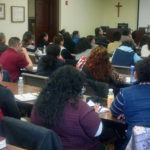By Deacon Frank Agnoli
For The Catholic Messenger
On Oct. 25, the Congregation for the Doctrine of the Faith released a new instruction regarding the proper care of human remains, whether the body itself or cremated remains. The instruction, Ad resurgendum cum Christo (To rise with Christ), sets out to restate the “doctrinal and pastoral reasons for the preference of the burial of the remains of the faithful and to set out norms pertaining to the conservation of ashes in case of cremation” (cover letter, Cardinal Gerhard Müller).
This new instruction, written to the church around the world, does not change the norms governing cremation, funerals with cremated remains, or the disposition of those remains in the United States. In 1997, the dioceses of the United States received special permission (an indult) to allow — with the local bishop’s permission — the celebration of funeral rites in the presence of cremated remains. An Appendix on Cremation was added to the ritual book used for funerals (the Order of Christian Funerals; OCF). At that time, we were reminded that the church honors the human body even after death. Following the example of Christ, there is a strong preference for burial in the Christian tradition; the new instruction once again calls our attention to this important part of our faith (par. 3). In addition, burial in a cemetery, especially a Catholic cemetery, is a powerful sign that even in death we are still part of the church. As the instruction states:

From the earliest times, Christians have desired that the faithful departed become the objects of the Christian community’s prayers and remembrance. Their tombs have become places of prayer, remembrance and reflection. The faithful departed remain part of the Church who believes “in the communion of all the faithful of Christ, those who are pilgrims on earth, the dead who are being purified, and the blessed in heaven, all together forming one Church” (par. 5)
Even if cremation is chosen, because of the honor we pay the body, the church prefers that the vigil and funeral be celebrated with the body present. If celebrated in the presence of cremated remains, some adjustments are made to the rite and prayers. In addition, the church insists that cremated remains be treated with the same respect as the body. Any action that turns the body into a “thing”— a commodity — for us to manipulate is therefore not permitted. Even the term “cremains” subtly (or not so subtly) moves us in this direction. As a result, scattering the ashes, dividing them up, making them into other objects, or even keeping the urn with cremated remains in the home is not allowed (paragraphs 6-8). We would never do these things with a body before cremation; we should not do them with a body after. Not only do these practices disrespect the body, but in some subtle ways may reflect our misdirected desire to control death and deny its finality or to reduce death to a private matter rather than a mystery that involves the entire church. Our faith in the Resurrection calls us to more than that.
Does this new instruction change liturgical law in this country? No. Even the admonition that a Christian funeral may be denied to someone who chooses “cremation and the scattering of their ashes for reasons contrary to the Christian faith” (par. 8) is not new. But it does serve to remind us of what existing law does call for: human remains, even if cremated, are to be treated with utmost respect.
(Deacon Frank Agnoli is director of liturgy for the Diocese of Davenport.)











